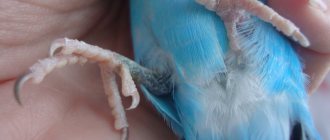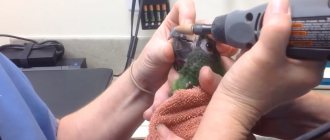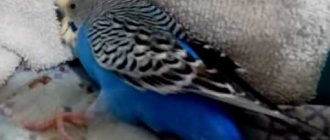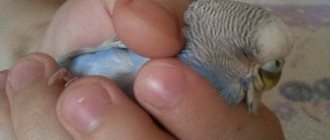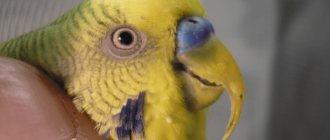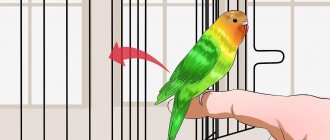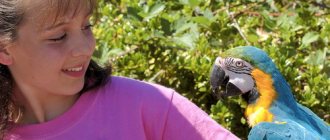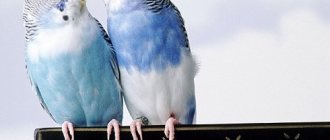Like any other pet, a parrot needs a balanced diet and clean water, because this is the basis of its health and longevity. Therefore, a bird’s unexpected refusal of food or water causes justified concern for its owner. Find out what could be the reasons for this and how long the parrot can remain without water and food.
What to do if you bought a parrot, but it sits in one place, neither eats nor drinks, and also for what reasons does the bird refuse to eat if it has been living in the house for a long time?
Preliminary preparation
If you decide to get a parrot, know that you will soon have not a toy, but a new family member. It is very important to prepare for its appearance in advance: arrange a home for the bird.
The cage must be made of quality materials. The rods are not painted and do not contain lead, zinc or copper. Italian cages are considered to be of higher quality than, for example, Chinese cages, which can be made from materials hazardous to the health of parrots.
The size of the parrot's house is at least 25x30x40 cm. The bottom should be retractable so that you can easily clean it without disturbing your bird.
Attention! The more space a bird has for maneuvers (flying, fluttering, climbing), the healthier it will be.
For the future house you need to find a suitable place:
- should not be in direct sunlight and at the same time should be well lit, including the installation of ultraviolet lighting;
- drafts are not allowed - birds are very sensitive to them;
- It should also not be placed close to heating appliances;
- try to place the cage in a place where it will touch the wall on one side - this will create a feeling of security for the parrot;
- The pet should be in its house at the level of your eyes, neither higher nor lower, so that it develops the correct behavior and perception of people.
For the first time after purchasing a parrot, it is advisable to cover the two walls of the cage with a light, dark cloth - this will save it from stress, creating a feeling of privacy.
Inside should be:
- two or three branches in the form of perches from fruit trees, minimum diameter - 15 mm. There is no need to remove the bark from them - roughness and unevenness will be an excellent prevention of paw disease and claw grinding;
- two stable feeders (for wet and dry food), a drinking bowl with fresh water;
- two or three toys;
- a bath of water, especially in the hot season.
Before you put the cage in place, be sure to thoroughly disinfect it and all its contents (toys, perches, drinking bowl, feeders): wash with soap, scald with boiling water, and dry. If you prepare everything in advance, your budgie will have a much easier time adjusting after purchase.
Types of feeders
Proper installation of feeders in the cage is of great importance for the bird. Depending on the type of parrot, this item is installed differently. For example, “wavy fish” are not picky and eat from plastic containers installed in special clamps on the cage. For some species with a strong and large beak, such as Grays and Macaws, plastic feeders are prohibited. The cockatoo enjoys moving around on the ground, so the feeder should be at the bottom of the cage. Some species prefer containers suspended in the enclosure.
- Mounted. There are two types: internal and external. The first type is installed inside on the horizontal bars of the cage. The second type of feeder has a special perch on which the pet sits while eating. Installed in specially designated areas in the cage. Secured with a clamp. Used for small and medium parrots. The material is non-toxic plastic or stainless steel. The second option is more practical, easy to clean and disinfect. Used during quarantine.
- Floor-standing. Installed on the bottom of a cage or enclosure. The material for the bowl is plastic or ceramic. When choosing, pay attention to the stability of the item. Birds easily turn this object over. Used for small, medium, large bird species. Both dry food and fruits and vegetables are poured.
- Automatic feeder (hopper). A special device allows you to pour a large amount of feed into the container. As the mixture disappears from the bottom, grains will be added.
Parrot behavior after purchase
A pet that comes into your home experiences extreme stress due to the sudden change in environment. He needs time to get used to and master new territory. Of course, in such a situation the parrot will not be at all ready to communicate with its owner. Therefore, it is important not to rush into adapting a budgie after purchase.
Doesn't eat or drink
Many owners of these birds will confirm that on the first day of their arrival in a new home, the parrot does not eat. The main reason for this is stress.
It may also be that the bird feeder is unusual, or the parrot does not notice it at all. In this case, carefully approach him and, without making sudden movements, bring the feeder to him. When the bird sees the food, and even if it begins to peck at it, return the feeder to its place and leave the room so that the wavy can eat in peace.
You can also sprinkle some grains directly on the bottom to feed your pet. It is important to prevent him from feeling hungry for a long time.
The reasons why a parrot doesn’t drink are the same: he’s still afraid of everything or he’s not used to the sippy cup. Perhaps the bird used to drink from a bowl, and now it does not know how to handle the sippy cup. Place a bowl of water at the bottom of her cage and observe. Perhaps this particular container will be preferable for her.
Some owners cannot say with certainty that their parrot does not drink. Birds often drink in swoops, quickly and rarely. Make a mark on the sippy cup with a marker and the next day check to see if the amount of water in the sippy cup has decreased. Most likely there will be less water.
Important! Do not forget to change the water daily, while thoroughly washing the sippy cup so that slippery deposits do not appear on its walls.
It is normal that in the first days after purchase the parrot does not eat or drink; gradually it will calm down, get used to it and the problem will resolve itself.
The bird rushes about or sits motionless, liquid droppings
In reviews, many owners describe how their budgerigar behaves during the adaptation period: some rush around the cage, reacting in panic to every movement of a person, others freeze on the perch, ruffle their feathers and carefully monitor what is happening, others huddle in a corner at the bottom of the cage and do not make no sound.
If you tactfully and carefully accustom your pet to you, it will gradually get used to it, but for now the bird simply does not know what to expect from you and what to count on.
Over time, both panic and numbness will pass, and your pet will feel confident.
Gastrointestinal disorder
Liquid droppings in a parrot do not always signal poisoning or some kind of disease. This may be a consequence of adaptation due to stress.
Usually everything returns to normal within a couple of days, but if nothing has changed, then it is better to take the wavy to a specialist who can accurately determine the cause of the disorder by analyzing the litter.
Another cause of gastrointestinal upset may be the low-quality food that the parrot eats. There are quite a few quality complaints about Chika grain mixtures; they are certainly cheaper than their foreign counterparts, but is it worth saving on the health of the bird?
And given that treatment will ultimately negate such savings, provide your wavy with high-quality food that includes all the necessary substances.
In addition to food, some owners give parrots white bread crackers, which can also worsen the digestion process and the general well-being of the wavy.
In case of food poisoning, diet is a good solution. Feed your parrot children's dairy-free porridge without added fat and salt, and give it an absorbent drink. Some owners use activated carbon; unfortunately, it absorbs not only harmful, but also beneficial substances. Well suited for treatment: enterosgel, smecta, enterodes and polyphepan.
Before giving the drug to your parrot, you need to dilute it with double the amount of water. Be sure to switch to expensive imported food if you have not done so right away. And carefully read the composition for the presence of iodine. Mixtures containing this substance are medicinal food.
How to behave with a parrot during adaptation
You will need to be as patient as possible and understand the condition of your budgie after purchase. To prevent the adaptation from being delayed, give him time to get used to it and don’t disturb him again. Let the bird examine the situation in the room, explore its house and gradually understand that this is a safe territory.
While the habituation is underway, do not make noise in the room with your pet, do not turn on the TV or music loudly, do not invite guests, do not scream or make sudden movements near the parrot. Try to keep the room away from other pets and small children. And be in the room yourself less often, at least for the first couple of days. You will still have time to get to know the parrot, let it get used to the surroundings.
Moreover, you should not try to pick him up, and you should only open the cage to change the water or give him food.
When you notice that your pet’s fear is gradually disappearing, talk to him in a quiet voice and call him by name.
Until the parrot has fully adapted after purchase, there is no need to let it out of the cage to fly. A bird may rush around an unfamiliar room in fear, hitting furniture, and it’s good if it doesn’t get hurt. And then it will be very difficult to drive the parrot back into the cage.
Of course, each bird is individual and its reaction to a change in its usual environment may not always meet any standards. It is of great importance what kind of chick you acquired: tame or untamed - the manner of communication with them is strikingly different. In this video you will learn how to behave with a tame pet you just bought and how to behave with a non-tame one:
How long can a parrot live without food?
It has been noticed that the smaller the parrot, the faster it weakens without normal nutrition. The most important factors for the survival of a bird are: the age of the pet and its physical condition.
On average, budgies can live for about 3-4 days without food. If a pet's feathers begin to fall out, this indicates the beginning of irreversible processes in its body that lead to death. Such a parrot requires specialist treatment immediately.
If the bird is too weak, you can maintain its strength with baby food diluted with water. A syringe without a needle is filled with warm liquid gruel and food is injected into the parrot's beak. This is how you need to feed the bird until signs of improvement from drug treatment appear.
Important! If a parrot eats little or does not eat for more than 2 days, there is a real threat to its life.
What not to do
In addition to the fact that you should not make noise near the bird and try to speed up the parrot’s adaptation after purchase, there are several other actions that you should not do if you want to establish friendly relations with it:
- If you buy a bird in a store, do not transport it in a cage in which it will later live. Otherwise, this home will cause a lot of negative emotions, as it will be associated with severe stress.
- Do not smoke indoors with your pet and do not place flowers near it that it might chew. All this can greatly harm his health.
- You should not move the parrot's home trying to find a better place. This disorients the bird and prevents it from getting used to its surroundings.
- You shouldn’t hover around your pet all the time; trying to pick up an untamed bird, catching it in a cage - such attempts sometimes end in the death of the parrot from a broken heart.
- It would be a mistake not to feed, hoping that hunger will force the bird to trust you and eat from your hand. Considering that budgies need to eat frequently, prolonged hunger will lead to digestive problems.
- There is no need to try to communicate with a bird when he is not in the mood - this may discourage him from communicating with you.
- Also, there is no need to try to treat a bird for diarrhea that occurs after it appears in your house - with treatment you are more likely to harm it.
Important! If you have other birds, do not introduce a newbie to them at first. It is necessary to endure quarantine. Firstly, you will protect your pets from infection if the newcomer does turn out to be sick with something. Secondly, give the newcomer time to get used to the new conditions without additional stress.
If you give your budgerigar the opportunity after purchasing to be alone and explore everything around him in a calm environment, the adaptation process will not take long. After a short time, your pet will trust you completely and you will enjoy communicating with each other.
In this video, the bird has already passed the adaptation period and is making its first flight out of the cage:
Worms
Being in the intestines of a parrot, in addition to disrupting the digestion process, the parasite creates conditions for infection of bacteria throughout the body. The waste products released by the worms poison the bird’s body, and intoxication begins. The central nervous system is damaged.
In some cases, intestinal blockage occurs. Symptoms of infection are apathy, severe weight loss, decreased or complete loss of appetite. Treatment is prescribed after the specific type of parasite has been identified. These can be: roundworms, tapeworms, capillaries.
Diagnosing worms is complicated by the fact that it is difficult to see the eggs of the parasite in a pet's droppings. It is recommended to analyze the feathered feces during the maintenance and care of birds. Treatment of the disease is carried out at home. The drugs Panacur, Albendazole, Pyrantel, Kanikvantel, Drontal are prescribed. Dosage and methods of treatment are prescribed by an ornithologist.
Poisoning of the body
Poisoning of parrots, as a rule, occurs when consuming low-quality grains, water, vegetables and fruits containing nitrates. Poisoning from poisonous indoor plants and medications. Due to inhalation of chemical aerosol substances.
Severe intoxication can cause paralysis. Adsorbent preparations are used to combat poisoning. Medicines are administered in liquid form using a pipette or insulin syringe. The dosage and course of treatment are individual for each type.
There is no such thing as weight loss without a reason. For birds kept in captivity, the presence of such a symptom indicates an inattentive, and in some cases, disdainful attitude towards the bird. A balanced diet and timely recognition of the disease will guarantee the health and longevity of the parrot.
Doesn't drink water
Oddly enough, very often it turns out that a budgie drinks water, it’s just that the owner cannot always monitor these moments. The parrot drinks quite little and rarely, so there is a feeling that the bird is not quenching its thirst at all.
Of course, there may be a problem similar to finding food in a new cage, when the budgie cannot find its way. An additional open drinking bowl located at the bottom of the cage will help with this problem. The heavier the bowl, the less chance the parrot will have of turning it over; ceramics are perfect for this purpose.
If fruits and vegetables appear in a parrot’s diet quite often, then it will more than replenish its water balance with the help of them. And seeing with your own eyes how a wavy bird drinks from a drinking bowl is not at all easy.
Such a miniature and active bird like a budgerigar is not able to live without water for more than three days, which means that any ailment will immediately become obvious to the parrot's owner.
When a bird is cheerful, active, without external changes, then this is a clear sign of health and a reason to stop worrying in vain.
New house
Try pouring a small portion of the food into the bottom of the cage first; perhaps the bird will be more accustomed to eating this way. Refusal to feed in the first days is quite normal, which is why you shouldn’t panic, the main thing you need to do is be patient.
The bird adapts much faster in calm conditions, where there is no loud, harsh sound from the TV or speakers. Try not to raise your voice near the cage, and also not to make active hand gestures, they can scare the wavy and only increase the state of stress.
It is better if during the first few days you do not try to make close contact with the bird; it should get used to you by observing the room and the behavior of those around it. The cage should only be opened to replenish water supplies and add food; try to speak kindly and quietly to the bird during meetings.
It is quite possible that the bird does not eat anything for the first few days because it does not understand where the food is, because the surrounding conditions and the cage have changed. Stock up on several feeders and drinkers in advance; first place them around the cage with poured food. This method will help the budgerigar quickly find its way and locate food and water.
It is also quite normal if the bird behaves like a “dummy” and does not respond to drinking bowls and food scattered under its paws; such torpor will subside in a couple of days.
Colds
During a cold, the parrot's activity decreases. Inflammation of the oral cavity and nasal mucosa is accompanied by frequent sneezing with secretion.
Depending on the type of cold, heavy breathing, trembling, and tilting of the head appear. The parrot loses weight, and along with this its vitality decreases. The bird refuses to drink and eat, which causes rapid weight loss.
An exhausted bird is not able to overcome the disease on its own. Mandatory human intervention is required. In addition to physiotherapy procedures related to heating and inhalation, artificial feeding of your feathered friend will also be required.
Tracheal mite
The reason for refusal to consume food is the infestation of birds with tracheal mites. This disease occurs quite often. The tick leads to changes in the trachea, damage to the mucous membranes and a significant disruption of the gastrointestinal tract functions.
He says about the disease:
- frequent cough with difficulty breathing;
- regurgitation of food;
- refusal of food;
- lack of response to external stimuli.
Due to infection of the trachea, the chick constantly throws back and stretches its head, trying to free its throat from foreign bodies. Accurate diagnosis and treatment are recommended to be carried out in a clinical setting. The drugs used are Ivermectin, Permectin, and a combination of Imidacloprid. A sick bird is quarantined. Preventive treatment is carried out for individuals in contact with a sick parrot. The place of detention must be disinfected.
Using safe food from well-known manufacturers, clean water and periodic sanitary treatment is the key to a healthy life for your pet. It is required to carefully observe the external condition of the bird. Timely detection of the disease will allow the parrot to be cured in a short time.
You bought a pet, brought it home, anticipating how great it would be to play with it and listen to its cheerful chirping. But you notice that after the purchase, the parrot does not eat or drink, sits huddled in the corner of the cage, or in panic shys away from your every move. Today we will talk about the adaptation of budgies, mistakes and what you need to do to make the bird get used to you as quickly as possible.
The parrot eats little, often itches, and twitches its wings.
he may be nervous due to metabolic disorders against the backdrop of deteriorating health. As a result, marks appear on the paws. Therefore, you need to change the perches to wooden ones that are thick enough for the bird to wrap around 2/3 of them. Now wrap all the perches with jute rope or a rag (so that the wood is not hard, so that it is soft for the paws). If there are abrasions to the wounds, then you can lubricate the top with levomikol (iruksovetin) to speed up healing. The wound itself should be washed and soaked with a warm antiseptic (chlorhexedine or miramistin). And you need to gradually restore the bird’s health with proper nutrition with permitted fruits and vegetables, high-quality food, and cereals. Have you ever been given vitamins? If yes, which ones? Be sure to start giving Creon now, then Karsil will be a good idea to give.
